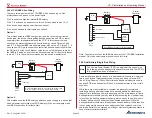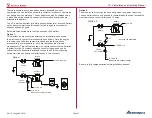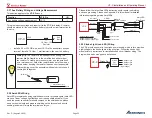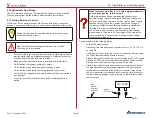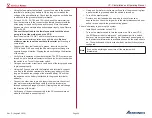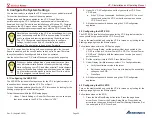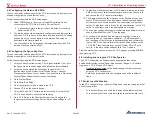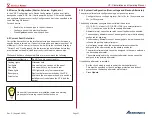
Page 64
VP-X Installation and Operating Manual
Rev. D (August 5, 2020)
8. Flight Test
This section verifies the proper operation of the VP-X during flight.
Prior to flight, make sure you understand the following, which is described in
the Operating section:
• How to clear faults
• How to switch devices on and off manually
• How the runaway trim system operates
This section provides a series of recommended steps, and you should
incorporate these steps into the overall flight test plan as you deem
appropriate. Go back and review the ground test steps, as complete and
thorough ground testing will mitigate the risk of trouble while airborne.
Do not fly the aircraft until you are comfortable everything
operates correctly on the ground, and you are knowledgeable
about the systems and their proper operation.
8.1
Notes about first flight
It is the pilot’s responsibility to develop a test plan that ensures a safe and
productive first flight. Typically, the first flight is focused on verifying basic
flight characteristics and proper engine operation. With that in mind, we
recommend deferring complete electrical system tests until after you are
comfortable that the engine and airframe are performing as expected,
and you are comfortable flying the aircraft. We recommend the following
configuration for first or early flights, and it can easily be changed for later
flights:
•
Configure the flaps to operate in
momentary
(flaps only move when
the flap switch is pressed). It may take a few flights to “dial in” the
proper limit settings for
position
(flaps move to next position when
flap switch pressed), and you can do that once the basic flight
characteristics are proven.
• Be sure to review how to acknowledge and/or reset circuit faults.
If you are installing the system as a retrofit, it is still important to complete as
much of the testing on the ground as possible.
8.2
VP-X system checkout
Now that initial aircraft checkout flights are complete, you can proceed with
the electrical system tests.
Once airborne, keep an eye out for traffic and obstacles during the test
procedure. Carry a handheld radio as a backup in case of electrical system
failure. If you encounter any difficulties in flight due to improper setup or
unknown electrical system behavior, land as soon as practical or simply turn
off the master switch. If you have completed a thorough check out on the
ground, the chances of problems while airborne are greatly reduced.
Verify each of the following in flight:
• Verify devices turn on and off when switches are turned on. Looking
at the individual current draw is an easy way to verify something is
turned on.
•
Verify variable speed trim works as configured.
• Verify wig-wag operates as expected. Note: it may be easier to
test wig-wag on the ground using simulated data from the VP-X
configurator.
•
Verify flaps operate as expected. The air loads may necessitate
minor changes to the flap settings if configured with intermediate flap
stops.

